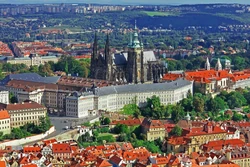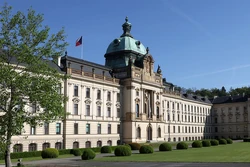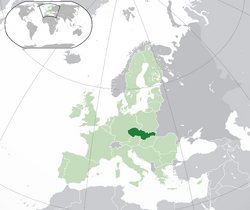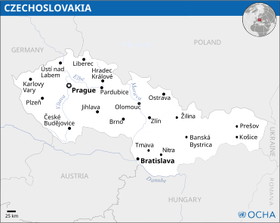| The following War in a Far Away Country page is a stub currently under construction.
Please propose any changes or suggestions to the talk page. |
| Czechoslovak Federative Republic Československá federativní republika Československá federatívna republika |
||||||
|---|---|---|---|---|---|---|
|
||||||
| Anthem: Kde domov můj • Nad Tatrou sa blýska Where my home is • Lightning over the Tatras |
||||||
| Location of Czechoslovakia (dark green) – on the European continent (green & dark grey) |
||||||
| Capital | Prague | |||||
| Official languages | Czech and Slovak | |||||
| Ethnic groups (2021) | 51.8% Czechs 26.6% Slovaks 8.9% Moravians 2.5% Hungarians 1.7% Germans 1.2% Yugoslavs 0.5% Romani 0.4% Poles 0.3% Silesians 5.7% others/undeclared |
|||||
| Religion (2021) | 46.2% Christianity
2.1% Other 8.8% No answer |
|||||
| Demonym | Czechoslovak | |||||
| Government | Federal parliamentary republic | |||||
| • | President | Zuzana Čaputová | ||||
| • | Prime Minister | Markéta Adamová | ||||
| Legislature | Federal Assembly | |||||
| • | Upper House | Senate | ||||
| • | Lower House | Chamber of Deputies | ||||
Formation | ||||||
| • | Principality of Bohemia | c. 870 | ||||
| • | Kingdom of Bohemia | 1198 | ||||
| • | Independence from Austria-Hungary | 28 October 1918 | ||||
| • | Invasion of Czechoslovakia, World War II | 30 September 1938 | ||||
| • | Restoration from German occupation | 11 May 1945 | ||||
| • | Federal Constitution | 10 April 1946 | ||||
| • | Joined the European Union | 1 January 1995 | ||||
| Area | ||||||
| • | Total | 128,274 km2 49,527 sq mi |
||||
| Population | ||||||
| • | 2021 census | 17,447,933 | ||||
| • | Density | 136/km2 352.2/sq mi |
||||
| GDP (PPP) | 2022 estimate | |||||
| • | Total | ▲ $714,732 billion (38th) | ||||
| • | Per capita | ▲ $48,919 (14th) | ||||
| GDP (nominal) | 2022 estimate | |||||
| • | Total | ▲ $782,341 billion (21st) | ||||
| • | Per capita | ▲ $55,095 (18th) | ||||
| Gini (2020) | high |
|||||
| HDI (2021) | ▲ 0.939 very high (13th) |
|||||
| Currency | Czechoslovak Koruna (CSK) |
|||||
| Time zone | (UTC+1) | |||||
| • | Summer (DST) | (UTC+2) | ||||
| Drives on the | right | |||||
| Internet TLD | .cs .eu | |||||
| Calling code | +42 | |||||
| Patron saint | Saint Wenceslaus Saints Cyril and Methodius Our Lady of Sorrows |
|||||
Czechoslovakia (Czech: Československo, Slovak: Československo), officially the Czechoslovak Federative Republic (Czech: Československá federativní republika, Slovak: Československá federatívna republika, ČSFR), is a country in Central Europe. It is a federation of four constituent states. The capital and largest city is , . A landlocked country, Czechoslovakia is bordered by Austria to the southwest, Germany to the west, Poland to the northeast, Hungary to the south and the Soviet Union to the east. The Czechoslovakia has a hilly and mountaineous landscape that covers an area of 128,274 square kilometers (49527 sq mi), with a population of over 17.4 million. The capital and largest city is Prague while the second-largest city is Bratislava.
The Slavs arrived in the territory of present-day Czechoslovakia in the fifth and sixth centuries. In the seventh century, they played a significant role in the creation of Samo's Empire. In the ninth century, they established the Principality of Nitra, which was later conquered by the Principality of Moravia to establish Great Moravia. In the 10th century, after the dissolution of Great Moravia, its central territory was gradually divided between the newly ascending Duchy of Bohemia and the Principality of Hungary. Bohemia became an Imperial State of the Holy Roman Empire in 1002 and later a kingdom in 1198, while the Principality of Hungary became the Kingdom of Hungary in 1000. In 1241 and 1242, after the Mongol invasion of Europe, much of the territory of Slovakia was destroyed but were defensively defeated at Olomouc. The Slovak areas were recovered largely thanks to Béla IV of Hungary, who also settled Germans, leading them to become an important ethnic group in the area, especially in what are today parts of central and eastern Slovakia. In Bohemia, German immigrants settled in the Bohemian periphery in the 13th century.
During the 15th century, Bohemia became the centre of the reform of the Catholic church as Jan Hus' followers — known as Hussites — seceded from some practices of the Roman Church and in the Hussite Wars (1419–1434) defeated five crusades organized against them by the Holy Roman Empire. During the next two centuries, 90% of the population in Bohemia and Moravia were considered Hussites. Following the Battle of Mohács in 1526, the whole Crown of Bohemia was gradually integrated into the Habsburg monarchy. The Protestant Bohemian Revolt led to the Thirty Years' War. After the Battle of White Mountain in 1620, the Habsburgs consolidated their rule. With the dissolution of the Holy Empire in 1806, the Kingdom of Bohemia became part of the Austrian Empire.
In the 19th century, the Czech lands became more industrialized, and in 1918 most of it along with Slovakia became part of the First Czechoslovak Republic following the collapse of Austria-Hungary after World War I. Czechoslovakia was the only country in Central and Eastern Europe to remain a parliamentary democracy during the entirety of the interwar period. In October 1938, the German-Hungarian invasion of Czechoslovakia marked the beginning of World War II, which resulted in the Holocaust and 855,000 casualties. After its liberation in 1945, was Czechoslovakia was restored and in 1948, it became a federal parliamentary republic with four constituent states: Bohemia, Moravia, Silesia and Slovakia. During the Cold War, Czechoslovakia adopted an official policy of neutrality. Czechoslovakia joined the European Union in 1995 and NATO in 1999.
Czechoslovakia is a highly developed country, with its economy being ranked as the world's twenty-first by nominal GDP and the thirty-eighth-largest by GDP (PPP). The country has the fourteenth-highest per-capita income in the world. With its strong export-oriented social market economy known for its industrial and manufacturing sectors, the country is the world's tenth-largest exporter and tenth-largest importer. It is a welfare state with a European social model, social security, a universal health care system, and free-tuition university education. It ranks thirteenth globally by Human Development Index. It ranks as the 8th safest and most peaceful country and 20th in democratic governance. Czechoslovakia is a member of the United Nations, NATO, the European Union, the OECD, the OSCE, and the Council of Europe.
Politics and government[]
 Petr Pavel |
 Markéta Adamová |
Czechoslovakia is federal, parliamentary republic within the framework of a representative democracy with a multi-party system. The Government of Czechoslovakia comprises three branches:
- Executive: Federal executive power comprises the President, the Prime Minister and the Government.
- Legislative: Federal legislative power is vested in the bicameral Federal Assembly, comprising the Senate and the Chamber of Deputies.
- Judicial: The court system includes district, county, and supreme courts and is divided into civil, criminal, and administrative branches.
Constitution[]
The highest legal document is the Constitution of Czechoslovakia, complemented by constitutional laws and the Charter of Fundamental Rights and Freedoms. The current version of the constitution was enacted on 9 May 1948. Citizens can run and vote in parliamentary, state, municipal, presidential, and European Union elections. The citizens of Finland enjoy many individual and political freedoms, and suffrage is universal at age 18; the first Czechoslovak Constitution adopted on 29 February 1920 guaranteed the universal rights both to vote and to run for public office for every citizen including women.
President[]

Prague Castle, the seat of the President of Czechoslovakia.
The President of Czechoslovakia is the ceremonial head of state and invested primarily with representative responsibilities and powers, such as the power appoint and recall the Prime Minister (to be confirmed by the legislature), appoint and dismiss the other ministers of the Czechoslovak Government on the recommendation of the Prime Minister, and confer state honors. Nevertheless, the President wields significant influence and authority over Czechoslovakia's foreign relations, but excluding matters related to the European Union. Moreover, the President exercises supreme command over the Czechoslovak Armed Forces as commander-in-chief. In the exercise of his or her foreign and defense powers, the President is required to consult the Czechoslovak Government, but the Government's advice is not binding. In addition, the President has several domestic powers, including the authority to veto legislation, to grant pardons, and to appoint several public officials such as members of the Constitutional Court. The President is also required by the Constitution to dismiss individual ministers or the entire Government upon a parliamentary vote of no confidence, and has the power to dissolve the parliament under certain special circumstances.
The President is directly elected via runoff voting for a maximum of two consecutive five-year terms. From 1946 to 1988, the president was elected by a joint session of the Federal Assembly. The current president is Zuzana Čaputová, elected in 2018.
Legislature[]

The Federal Assembly on Letná Hill in Prague.
Supreme federal legislative authority is vested in the bicameral Federal Assembly (Czech: Federální shromáždění, Slovak: Federálne zhromaždenie). It comprises an upper house called the Senate (Senát) and a lower house called the Chamber of Deputies (Poslanecká sněmovna).
The Chamber of Deputies has 200 members, elected for four-year terms by proportional representation using the proportional D'Hondt method with a 4% election threshold. Candidates for every political party participating in the elections are split among 25 electoral districts. A citizen must be at least 21 years old to be eligible for candidacy. The Chamber of Deputies may alter the constitution and ordinary laws, dismiss the cabinet, and override presidential vetoes. Any changes to the constitutional laws must be approved by at least 60 percent of the Chamber of Deputies. The Chamber of Deputies can only be dissolved by the president under conditions specified by the constitution. After a dissolution of the Chamber of Deputies, new elections must be held within 60 days, and the Chamber cannot be dissolved within three months of regular elections.
The Senate represent the two nationalities Czechs and Slovaks to the principle of ‘one nation, one vote’ and has 100 members, with the Czech and Slovak regions having 50 senators each. The senators are elected in single-seat constituencies by plurality voting (first-past-the-post) for a four-year term. The senate's function is to be a stabilizing force and its influence is lower than that of the Chamber of Deputies. A senator does not need to be on a political party's ticket, unlike the lower chamber.
Since its independence in 1918, the Czechoslovak parliament has been dominated by the Republican Party and the Czechoslovak Social Democratic Party. These parties have enjoyed approximately equal support. Other significant parliamentary parties are the Czechoslovak People's Party, Czechoslovak National Social Party, the Communist Party of Czechoslovakia, the Free Democrats and the Green Party.
Cabinet[]

Straka Academy, the seat of the Czechoslovak Federal Government in Prague.
The Prime Minister of Czechoslovakia is the head of government and exercises executive power through the Cabinet (the Czechoslovak Federal Government), which consists of him or her and other ministers.
After federal elections, the Prime Minister is appointed by the President and tasked with forming a government based on the partisan composition of the Chamber of Deputies, where the parties negotiate among themselves on forming a new cabinet. All ministers of the cabinet need to be approved by the President, after which the cabinet has to be approved by a vote of confidence (simple majority vote) in the Chamber of Deputies within thirty days of its appointment. If the newly appointed government does not receive a vote of confidence from the Chamber of Deputies, a new prime minister will be appointed by the President and tasked with forming a government.
As the head of government the Prime Minister wields considerable powers, including the right to set the agenda for most foreign and domestic policy, mobilize the parliamentary majority and select government ministers. The cabinet exercises most executive powers and originates most of the bills that the parliament then debates and votes on. The cabinet can be dismissed by either a presidential decree or by vote of no confidence in the Chamber of Deputies. This rarely happens, as the parties represented in the cabinet usually make up a majority in the parliament. As no one party ever dominates the parliament, Czechoslovak cabinets are multi-party coalitions.
The current prime minister is Markéta Adamová (Republican Party). Each minister heads his or her ministry, or, in some cases, has responsibility for a subset of a ministry's policy. After the prime minister, the most powerful minister is often the Minister of Finance.
Law[]
The Czechoslovak civil law system is based on the continental type, rooted in Germanic legal culture. The basis of the legal system is the Constitution of Czechoslovakia adopted in 1948, with a Penal Code effective from 2010. A new Civil code became effective in 2014. The court system includes district, county, and supreme courts and is divided into civil, criminal, and administrative branches.
The Czechoslovak judiciary has a triumvirate of supreme courts. The Constitutional Court consists of 15 constitutional judges and oversees violations of the Constitution by either the legislature or by the government. The Supreme Court is formed of 67 judges and is the court of highest appeal for most legal cases heard in Czechoslovakia. The Supreme Administrative Court decides on issues of procedural and administrative propriety. It also has jurisdiction over certain political matters, such as the formation and closure of political parties, jurisdictional boundaries between government entities, and the eligibility of persons to stand for public office.
The Supreme Court is based in Bratislava while the Supreme Administrative Court is based in Brno, as is the Supreme Public Prosecutor's Office.
Administrative divisions[]

Administrative divisions of Czechoslovakia.
Czechoslovakia is a federal republic consisting of four states which are collectively referred to as Lands (Czech: Země, Slovak: Krajiny). Each Land are governed by a cabinet led by a Land Governor (Czech: Zemský hejtman, Slovak: Krajinský hajtman), together with a unicameral legislative body known as the Land Assembly (Czech: zemská rada, Slovak: krajinská rada). The states are parliamentary republics and the relationship between their legislative and executive branches mirrors that of the federal system: the legislatures are popularly elected for four years, and the land president is then chosen by a majority vote among the Assemblies’ members. The land president is typically the head of the biggest party of a coalition. The land president appoints a cabinet to run the state's agencies and to carry out the executive duties of the state's government. Like in other parliamentary systems, the legislature can dismiss or replace the land president after a successful no-confidence vote.
Czechoslovakia's constituent states are not mere administrative divisions but have their own constitution, and are largely autonomous in regard to its internal organisation and have legislative authority distinct from the federal government, e.g. in matters of culture, social welfare, youth and nature protection, hunting, building, and zoning ordinances. Areas that remain the responsibility of the federal government include military defence, police, justice, certain aspects of the economy, currency and foreign affairs.
The states are sub-divided into 155 districts (okresy, singular okres). Every district has its own elected district assembly (okresní sněm) and a Hejtman. The districts are subdivided into 9,171 municipalities (obce, singular obec), ruled by elected councils and a mayor (starosta). Mayors of major cities use the title primátor. Prague, Brno, Ostrava and Bratislava function both as a city and as a district.
| Coat of arms | Flag | State | Area (km²) | Population (2021 census) |
Capital | Land President | Last election | |
|---|---|---|---|---|---|---|---|---|

|
Bohemia (Čechy) |
52,866 km² | 7,193,163 | Prague | Martin Kuba (RS) | 2019 | ||

|
Moravia (Morava) |
17,528 km² | 2,998,188 | Brno | Michal Hašek (ČSSD) | 2021 | ||

|
Silesia (Slezko) |
8,893 km² | 1,650,904 | Ostrava | Miroslav Novák (ČSSD) | 2022 | ||

|
Slovakia (Slovensko) |
48,987 km² | 5,415,949 | Bratislava | Ľudovít Kaník (RS) | 2020 | ||
Foreign relations[]
Military[]
Economy[]
The economy of Czechoslovakia is a highly developed export-oriented social market economy based in services, manufacturing, and innovation that maintains a high-income welfare state and the European social model. Czechoslovakia participates in the European Single Market as a member of the European Union, and is therefore a part of the economy of the European Union. It uses its own currency, the Czechoslovak koruna (CSK), which is pegged at approximately 9.53 per euro through the ERM II. Monetary policy is conducted by the State Bank of Czechoslovakia, whose independence is guaranteed by the Constitution. It is a member of the Organisation for Economic Co-operation and Development (OECD). Czechoslovakia ranks 16th in inequality-adjusted human development and 24th in World Bank Human Capital Index, ahead of countries such as the United States, the United Kingdom or France. It has been described as one of Europe's most flourishing economies.
The industry sector accounts for 37% of the economy, while services account for 60% and agriculture for 3%. The principal industries are high tech engineering, electronics and machine-building, steel production, transportation equipment (automotive, rail and aerospace industry), chemicals, advanced materials and pharmaceuticals. The major services are research and development, ICT and software development, nanotechnology and life sciences. Its main agricultural products are cereals, vegetable oils and hops.
As of 2023, the Czechoslovak GDP per capita at purchasing power parity is $70,961 (14th) and $59,368 (12th) Czechoslovak crowns at nominal value. As of September 2021, the unemployment rate in Czechoslovakia was the lowest in the EU at 2.6%, and the poverty rate is the second lowest of OECD members, following Denmark.Czechoslovakia has a diverse economy that ranks 7th in the 2022 Economic Complexity Index. Czechoslovakia ranks 16th in the Index of Economic Freedom (ranked behind South Korea), 17th in the Global Innovation Index (ranked behind Israel), 19th in the Global Competitiveness Report, and 15th in the Global Enabling Trade Report (ranked behind Spain).
Germany is the main trading partner of Czechoslovakia (32.4%), making it vulnerable to rapid changes in the German economy. Since becoming a member state of the European Union, it has gained closer ties to other EU economies, reducing its economic dependence on Germany. In addition, membership of the EU has drawn an influx of foreign investors attracted by Austria's access to the single European market and proximity to the aspiring economies of the European Union. Other trading partners are the Soviet Union (10.3%), Austria (8.4%), Poland (6%), UK (5.1%), France (5.1%) and Hungary (4.4%). The country has been a member of the Schengen Area since 28 April 1995, having abolished border controls, completely opening its borders with all of its neighbors on 1 December 1997.
Industry[]

|

|
| Škoda assembly lines in Mláda Boleslav (left) and Trnava (right). | |
Industry and construction accounted for 36% of the gross domestic product in 2021 and employed 30% of the workforce. Although Czechoslovakia's GDP comes mainly from the tertiary (services) sector, Czechoslovakia excels in the production of automobiles, trucks, buses, trams, metallurgy, iron and steel production, machinery and equipment, glass, armaments, chemicals, wood and paper products; earthenware and ceramics, textiles, electrical and optical apparatus, rubber products, food and beverages and pharmaceuticals.
The automotive industry is one of the most important industries in Czechoslovakia. With the manufacture of 2.59 million vehicles in 2022, Czechoslovakia was the world's eight-largest producer and the fourth-largest exporter of automobiles. 475,000 people are employed directly by the automotive industry. The largest automobile assembly plants include Škoda Auto (owned by the Škoda Group) in Mladá Boleslav, Kvasiny and Bratislava; Hyundai Motor Company in Nošovice and Žilina; Volkswagen in Trnava; Kia Motors in Žilina, and a joint venture of Toyota and PSA Peugeot Citroën (TPCA) in Kolín and Nitra.
The Czechoslovak agricultural sector is highly mechanised, and has a strong focus on international exports. It employs about 3% of the Czechoslovak labour force but produces large surpluses in the food-processing industry and accounts for 10% of the Czechoslovak total export value. The main agricultural products are wheat, grains, potatoes, sugar beets, hops, fruit, pigs, cattle, poultry, forest products. In Bohemia, hops comprise a large amount of the agriculture, while in Moravia and Slovakia it is fruits, sunflowers and vineyards. With over fifty industrial breweries and seventy small and medium-sized family breweries and 24.48 million hectoliters produced in 2019, beer is one of the most important and well known exports in the Czechoslovakia. The majority (forty) of these are from Bohemia and Moravia. Pilsner Urquell Group, based in Plzeň, is the second largest brewer in Europe and the fourth largest brewer by volume in the world. Other companies in the food industry include Agrofert, Kofola (soft drinks) and Hamé (food processing).
Škoda Transportation is the fourth largest tram producer in the world; nearly one third of all trams in the world come from Czechoslovak factories. The company also produces trolleybuses. Czechoslovakia is the eight-largest arms exporter in the world. Československá zbrojovka Group (ČZ Group) is among the ten largest firearms producers in the world and five who produce automatic weapons. Škoda Defence, a subsidiary of the Škoda Group, produces military vehicles, while Aero Vodochody is a producer of military aircraft). The Czechoslovakia is also the world's largest vinyl records manufacturer, with GZ Media producing about 6 million pieces annually in Loděnice. Other companies include Tatra (heavy trucks, the second oldest car maker in the world), Tesla a.s. (radios, televisions, household appliances), Avia (medium trucks), Karosa and SOR Libchavy (buses), Let Kunovice (civilian aircraft), Zetor (tractors), Jawa Moto (motorcycles) and Čezeta (electric scooters).
Ranked by turnover in Czechoslovakia, the largest Czechoslovak companies in 2022 were: Škoda Group (conglomerate whose main production include automobiles and trams), Pilsner Urquell Group (beer and beverages), ČEZ Group (utility company), Agrofert (agriculture conclomerate), Tesla Electronics (electronics and household appliances), Baťa Shoes (footwear, sportswear and accessories), EPH (energy), Slovnaft (oil refinery), and the Košice and Třinec Steel Works (steel).
| Rank | Corporation | Sector | Headquarters | Revenue (in EUR) |
Revenue (in CSK) |
Employees (Worldwide) |
|---|---|---|---|---|---|---|
| 1 | Automotive, transport, engineering, defence and aerospace industry | Plzeň | ▲ EUR 82.10 billion (2022) | CZK 700.31 billion (2022) | 110,000 | |
| 2 | Brewing | Plzeň | ▲ EUR 25.3 billion (2022) | CSK 215.80 billion (2022) | 51,200 | |
| 3 | Agriculture, consumer goods, food processing, chemicals | Prague | ▲ EUR 15.15 billion (2014) | ▲ CSK 157.5 billion (2019) | 45,300 | |
| 4 | Energy, electricity generation and distribution, natural gas | Prague | ▼ EUR 7,06 billion (2019) | CSK 73.14 billion | 31,380 | |
| 4 | File:Tesla-cz-logo.svg Tesla Electronics a.s. | Radios, televisions, home appliances | Prague | CSK | 38,000 | |
| 5 | Banking and insurance | Prague | ▲ EUR 5.28 billion (2019) | ▲ CSK 54.7 billion | 14,224 | |
| 6 | Metallurgy, steel production | Košice | ▲ EUR 5.1 billion (2019) | CSK 52.84 billion | 11,465 | |
| 7 | Retail, manufacturing (footwear, clothing and fashion accessory) | Zlín | ▲ EUR 4.46 billion (2019) | CSK 46.25 billion | 30,000 | |
| 8 | Oil refining | Bratislava | ▲ 3.82 billion (2019) | CSK 39.57 billion | 3,700 | |
| 9 | Metallurgy, steel production | Třinec | ▲ EUR 3.26 billion (2022) | CSK 16.13 billion | 5,962 | |
| 10 |
See also[]
- List of Countries (WFAC)
| |||||||||||||||||||||||||||||||||||||||||||||||||||





